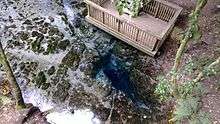Hamurana
Hamurana is a settlement and area of natural springs on the northern side of Lake Rotorua, in Rotorua Lakes within the Bay of Plenty Region of New Zealand's North Island. It includes the deepest natural spring on the North Island, emerging from a rocky area within the Hamurana Springs Recreation Reserve.
Hamurana Springs Recreation Reserve
The Hamurana Springs are a collection of springs on the site, officially named Hamurana Springs Recreation Reserve since 1971.[1]
Hangarua Spring
The main spring is 920 feet (280 m) above sea level and is approximately 15 metres (50 ft) deep. It produces an estimated 4 million litres of crystal clear water per hour at a fairly constant temperature of 10 degrees Celsius. The rock surrounding this spring is volcanic (rhyolitic). The spring water travels down from the Mamaku Plateau through underground aquifers, taking 70 years to get here.

Dancing Sands Spring
Another identified spring in the reserve is the Dancing Sands spring, named because of the effect of the emerging water on the sand on the bottom of the spring.
Hamurana Stream
The spring flows as a stream for approximately one kilometre in the Hamurana Springs Recreation Reserve through a patch of redwoods forest before joining Lake Rotorua.[2] In summer the stream is home to rainbow trout who prefer the cooler temperature of the spring water.
Ownership
Ownership of the springs and other nearby sites of cultural significance was returned to the Ngati Rangiwewehi iwi under the Ngati Rangiwewehi Claims Settlement Bill 2014.[3] The Act also declares the Hamurana Springs A and Hamurana Springs B as reserves subject to sections 17 and 18 respectively of the Reserves Act 1977.[4]
The Hamurana Springs Incorporated Society founded in 2003 by members of the Hamurana community, was a group of volunteers who were dedicated to restoring and enhancing the walkway to the springs.
Access for the public to the springs and reserve maintained by the local society was historically free, and continued free public access was rumoured to be a stipulation in the settlement; however, access is now fully enclosed and only paid access is available as of 2019.[5]
Education
Kaharoa School is a co-educational state primary school for Year 1 to 8 students,[6] with a roll of 179 as of March 2020.[7]
References
- "Place name detail: Hamurana Springs Recreation Reserve". New Zealand Gazetteer. Land Information New Zealand. Retrieved 12 March 2020.
- "Hamurana Springs track". New Zealand Department of Conservation. Retrieved 28 March 2009.
- "Ngāti Rangiwewehi Claims Settlement Bill 136-3B (2013), Government Bill Contents". New Zealand Legislation. Retrieved 21 March 2019.
- "Reserves Act 1977 No 66 (as at 21 December 2018), Public Act Contents". New Zealand Legislation. Retrieved 21 March 2019.
- "Hamurana – "Where Nature Comes to Sleep"". Retrieved 21 March 2019.
- "Ministry of Education School Profile". educationcounts.govt.nz. Ministry of Education.
- "Education Review Office Report". ero.govt.nz. Education Review Office.